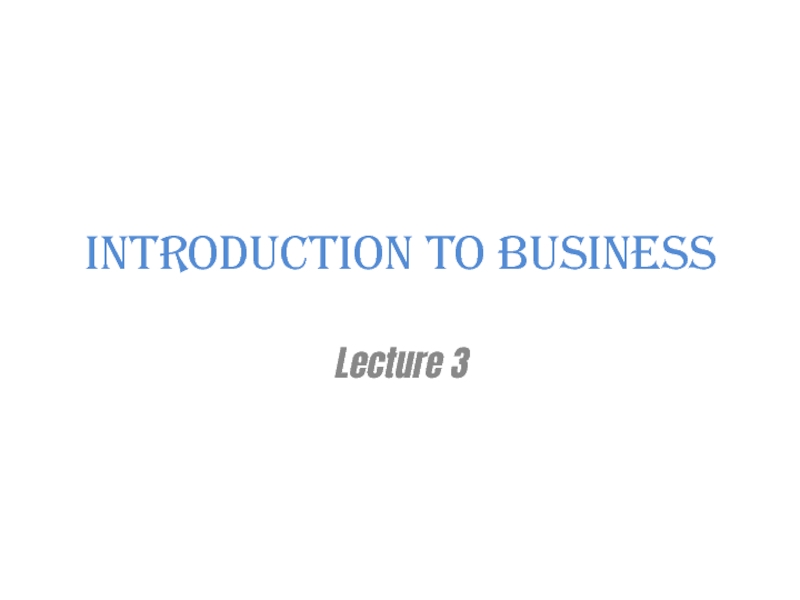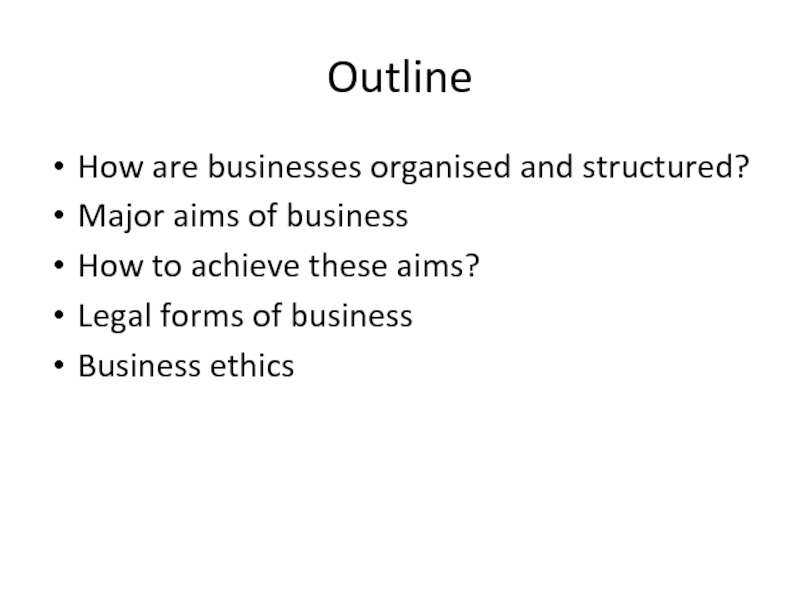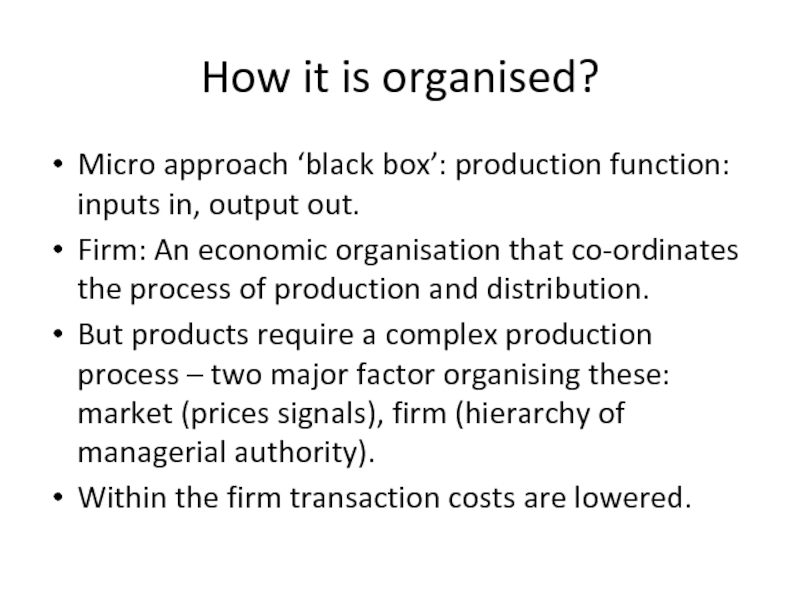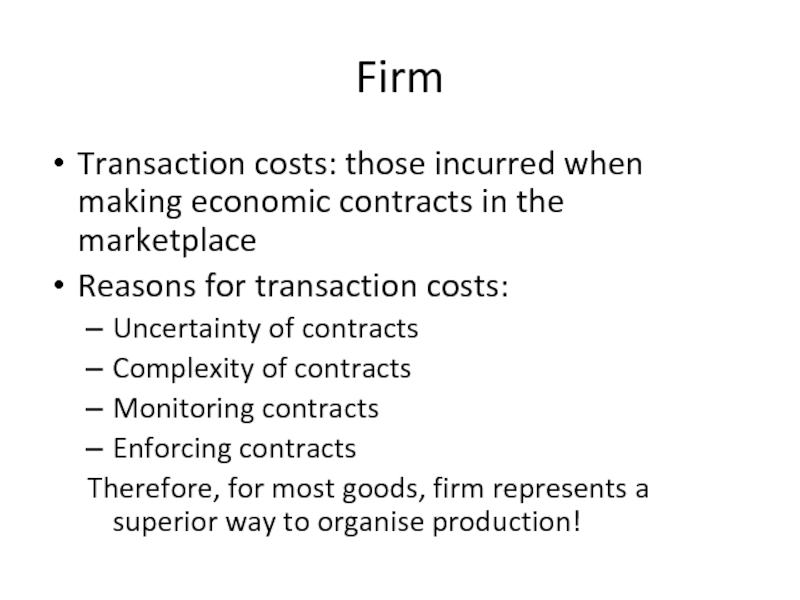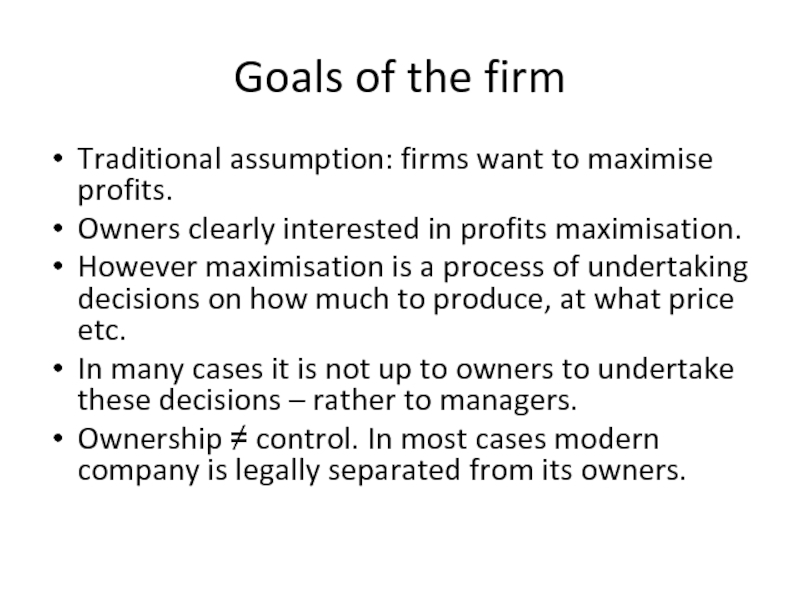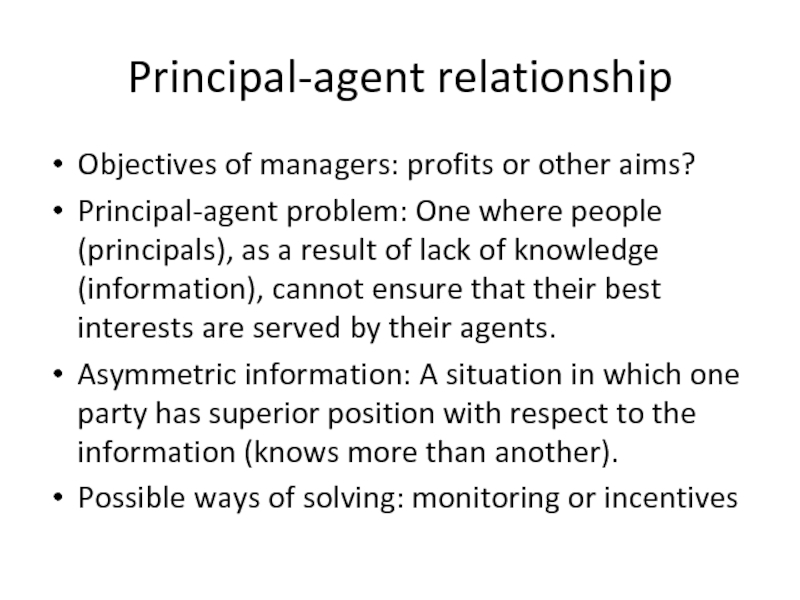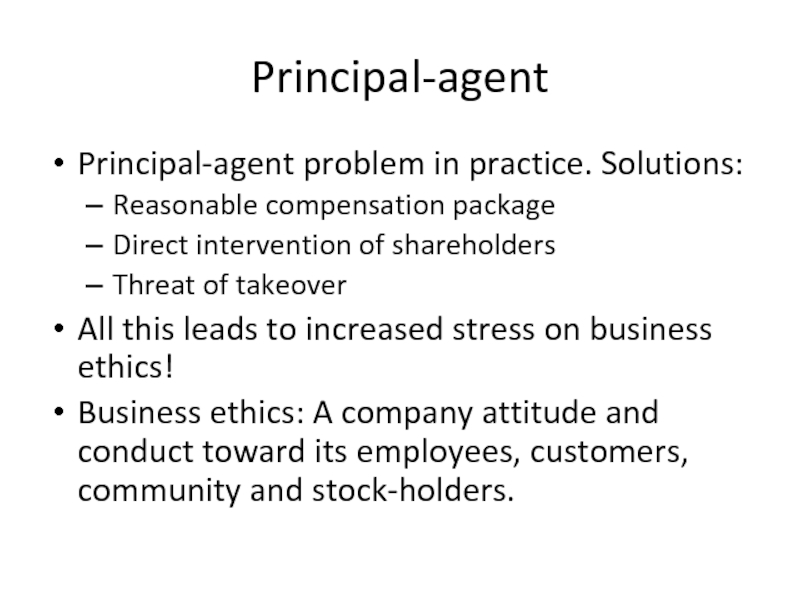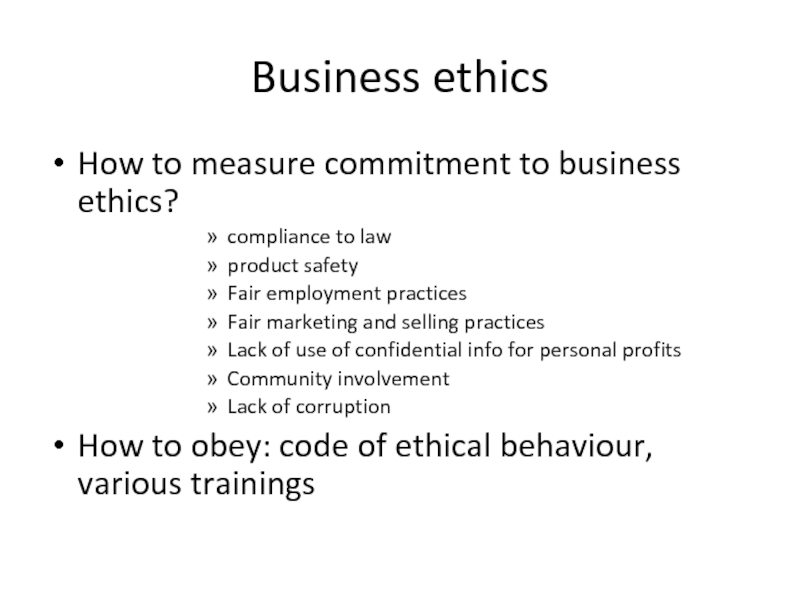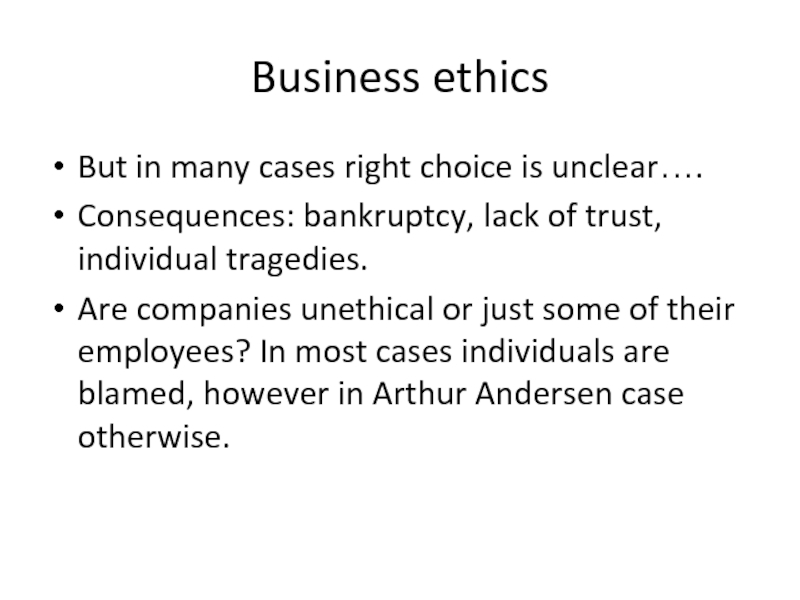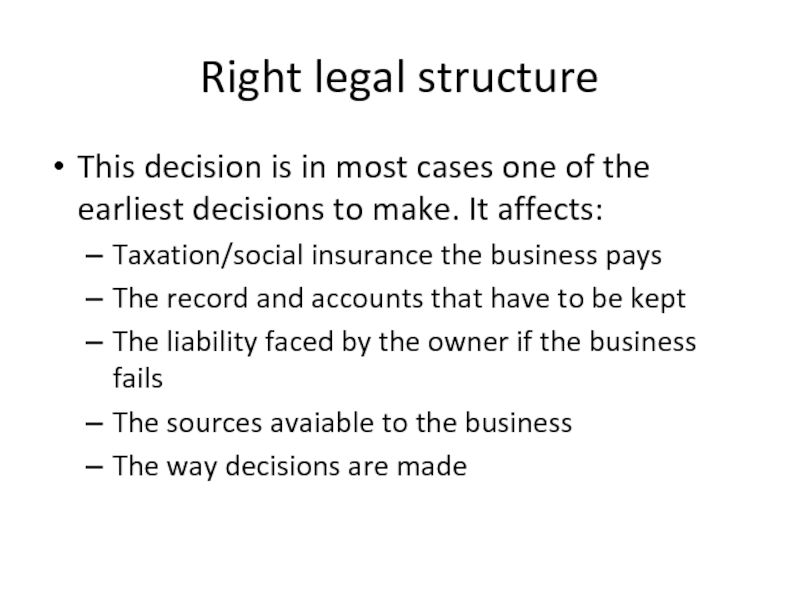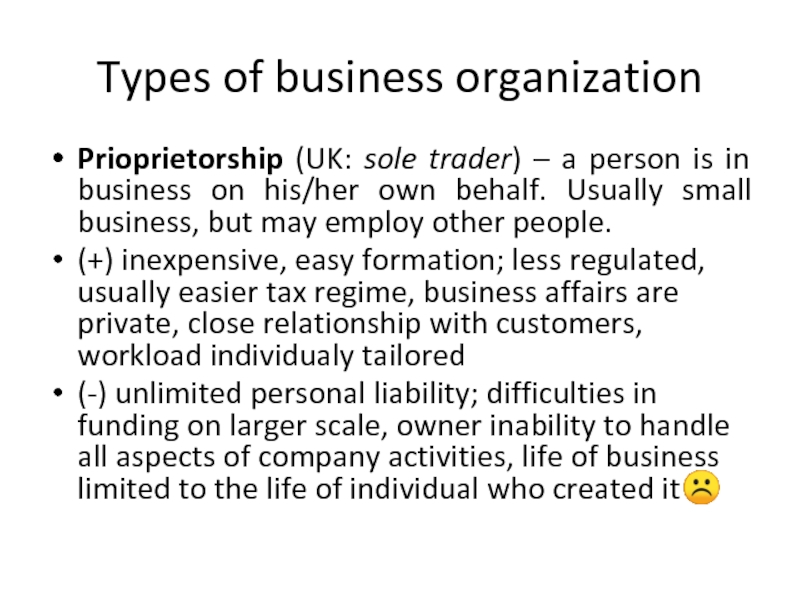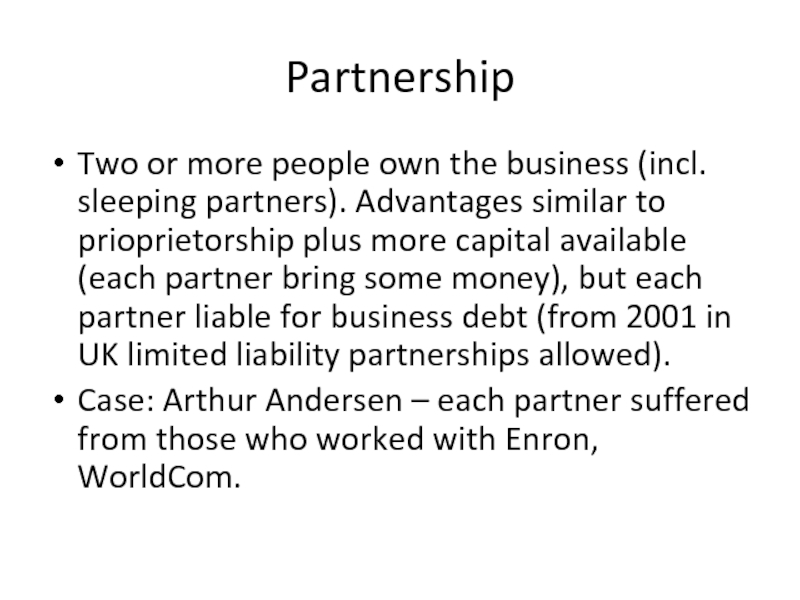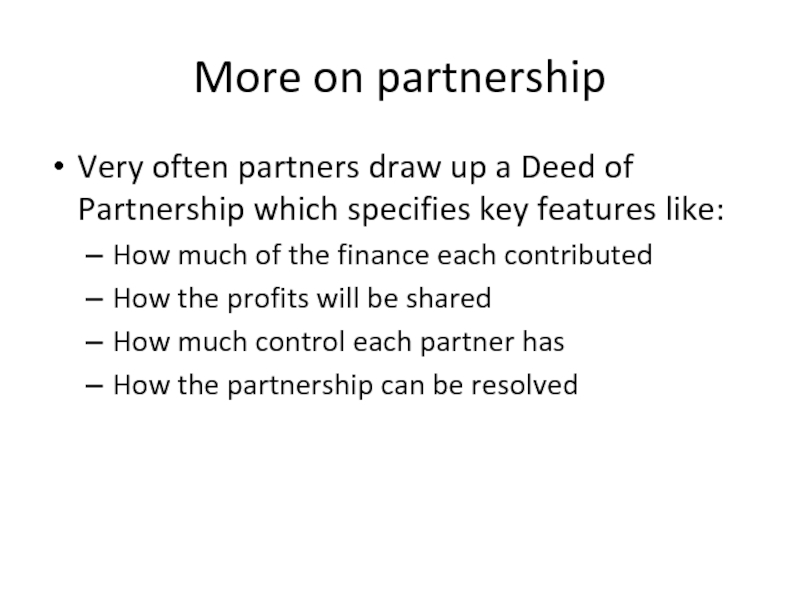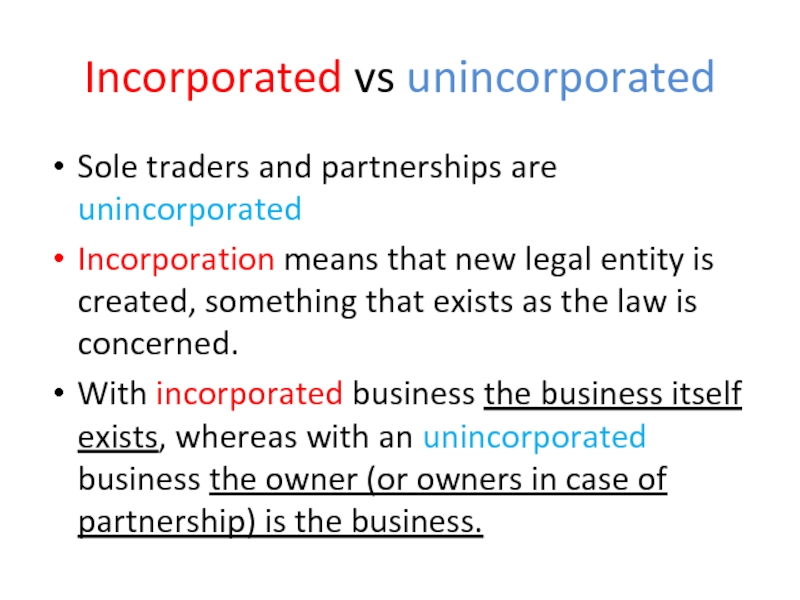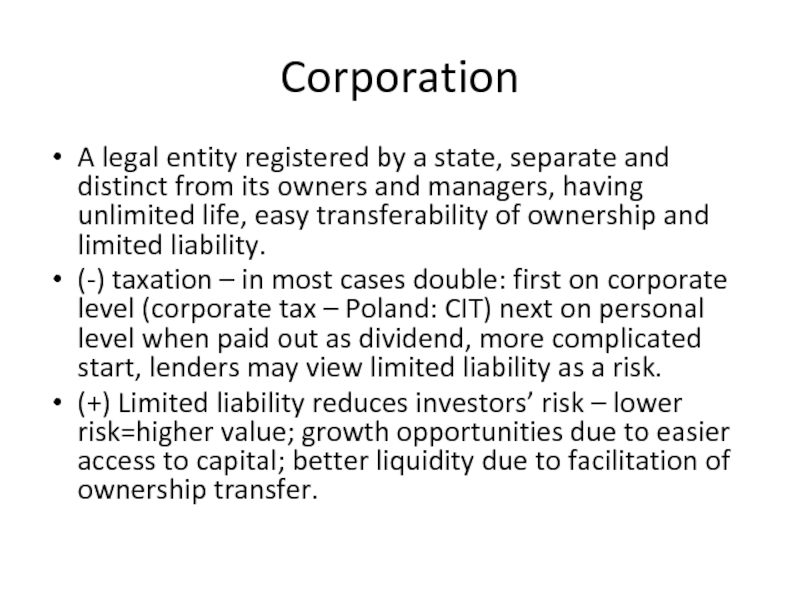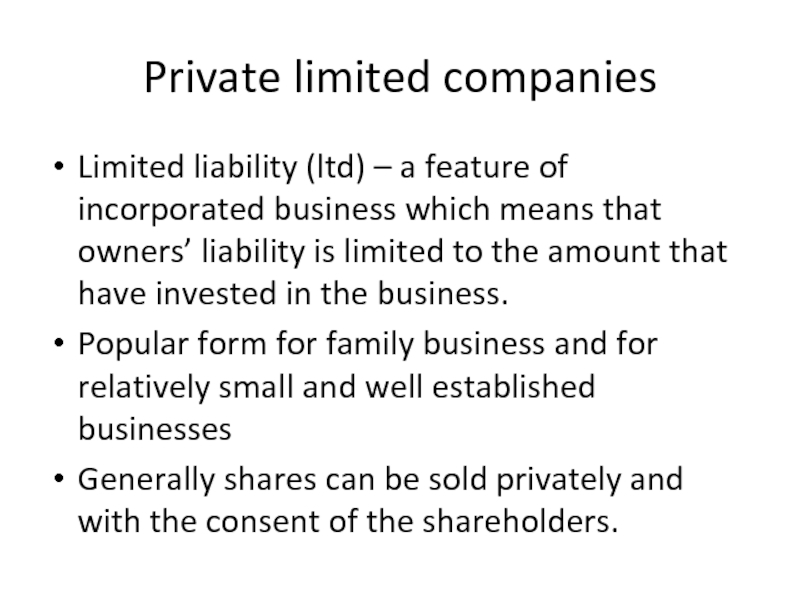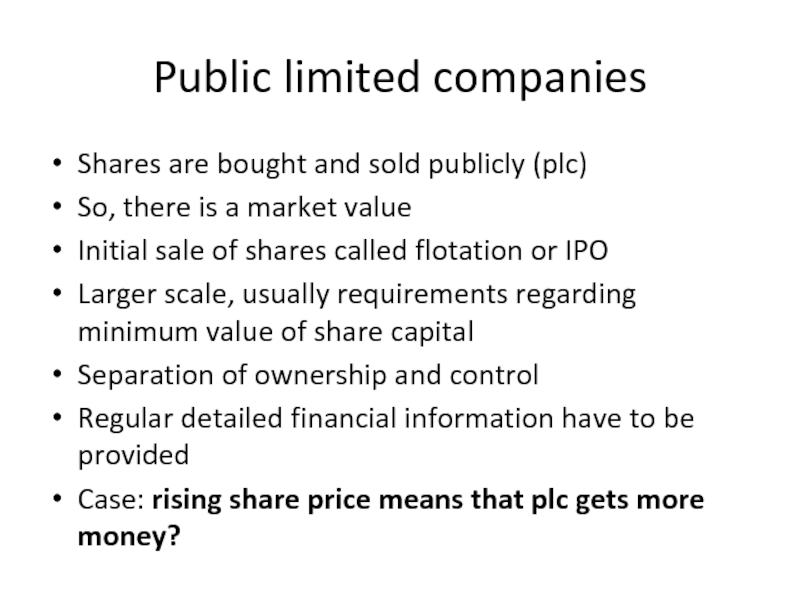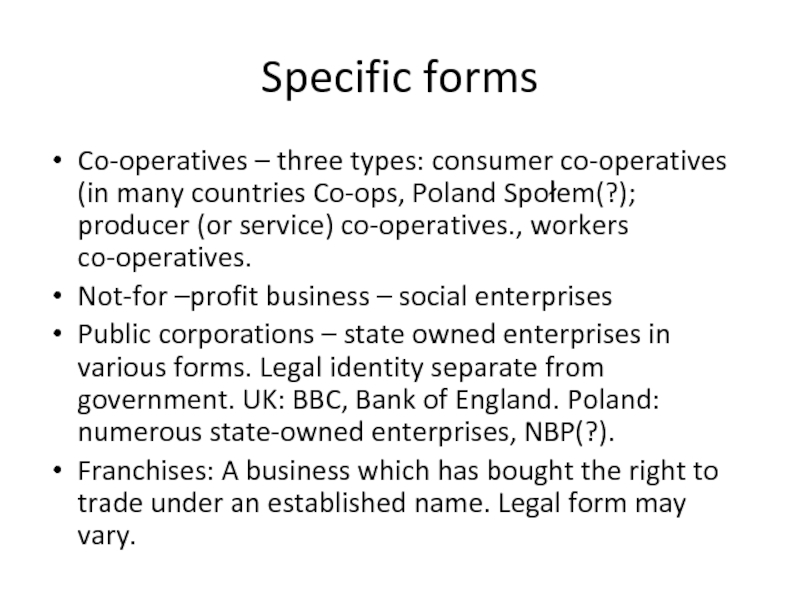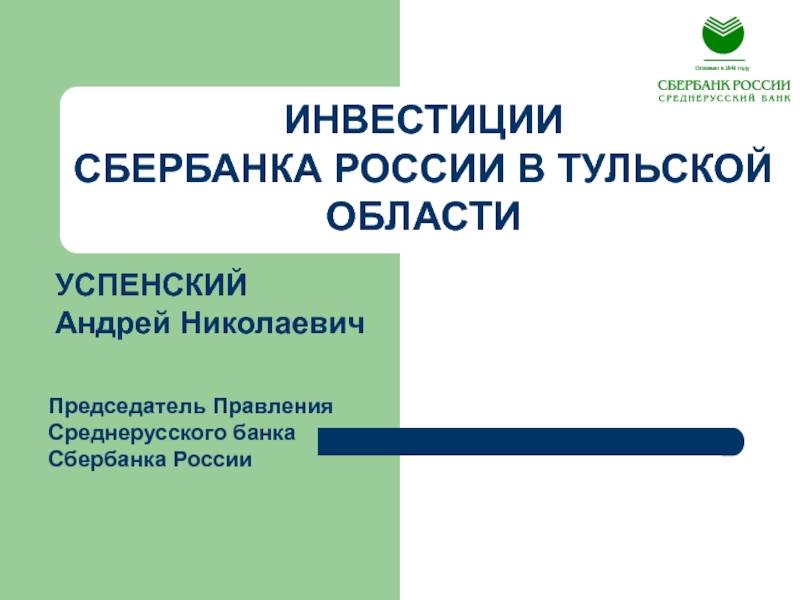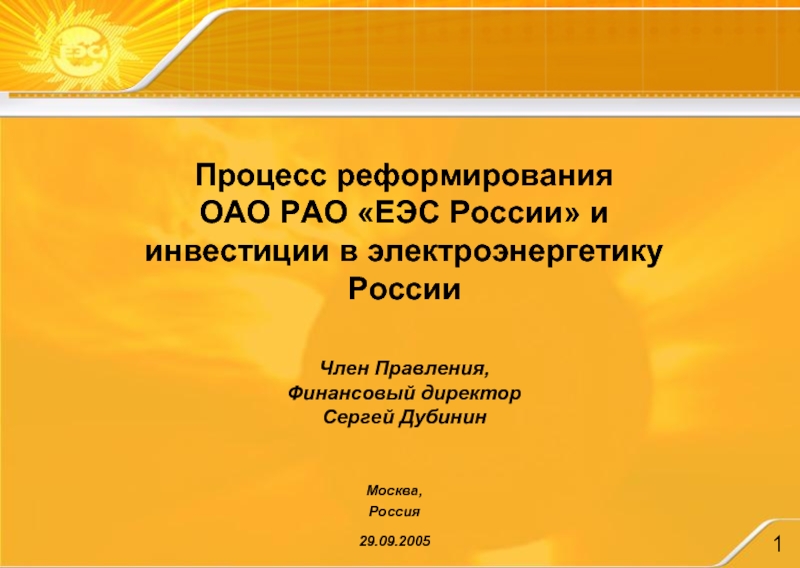- Главная
- Разное
- Дизайн
- Бизнес и предпринимательство
- Аналитика
- Образование
- Развлечения
- Красота и здоровье
- Финансы
- Государство
- Путешествия
- Спорт
- Недвижимость
- Армия
- Графика
- Культурология
- Еда и кулинария
- Лингвистика
- Английский язык
- Астрономия
- Алгебра
- Биология
- География
- Детские презентации
- Информатика
- История
- Литература
- Маркетинг
- Математика
- Медицина
- Менеджмент
- Музыка
- МХК
- Немецкий язык
- ОБЖ
- Обществознание
- Окружающий мир
- Педагогика
- Русский язык
- Технология
- Физика
- Философия
- Химия
- Шаблоны, картинки для презентаций
- Экология
- Экономика
- Юриспруденция
Introduction to business. Lecture 3 презентация
Содержание
- 1. Introduction to business. Lecture 3
- 2. Outline How are businesses organised and structured?
- 3. How it is organised? Micro approach ‘black
- 4. Firm Transaction costs: those incurred when making
- 5. Goals of the firm Traditional assumption: firms
- 6. Principal-agent relationship Objectives of managers: profits or
- 7. Principal-agent Principal-agent problem in practice. Solutions: Reasonable
- 8. Business ethics How to measure commitment to
- 9. Business ethics But in many cases right
- 10. Right legal structure This decision is in
- 11. Types of business organization Prioprietorship (UK: sole
- 12. Partnership Two or more people own the
- 13. More on partnership Very often partners draw
- 14. Incorporated vs unincorporated Sole traders and partnerships
- 15. Corporation A legal entity registered by a
- 16. Private limited companies Limited liability (ltd) –
- 17. Public limited companies Shares are bought and
- 18. Specific forms Co-operatives – three types: consumer
Слайд 2Outline
How are businesses organised and structured?
Major aims of business
How to achieve
these aims?
Legal forms of business
Business ethics
Legal forms of business
Business ethics
Слайд 3How it is organised?
Micro approach ‘black box’: production function: inputs in,
output out.
Firm: An economic organisation that co-ordinates the process of production and distribution.
But products require a complex production process – two major factor organising these: market (prices signals), firm (hierarchy of managerial authority).
Within the firm transaction costs are lowered.
Firm: An economic organisation that co-ordinates the process of production and distribution.
But products require a complex production process – two major factor organising these: market (prices signals), firm (hierarchy of managerial authority).
Within the firm transaction costs are lowered.
Слайд 4Firm
Transaction costs: those incurred when making economic contracts in the marketplace
Reasons for transaction costs:
Uncertainty of contracts
Complexity of contracts
Monitoring contracts
Enforcing contracts
Therefore, for most goods, firm represents a superior way to organise production!
Слайд 5Goals of the firm
Traditional assumption: firms want to maximise profits.
Owners clearly
interested in profits maximisation.
However maximisation is a process of undertaking decisions on how much to produce, at what price etc.
In many cases it is not up to owners to undertake these decisions – rather to managers.
Ownership ≠ control. In most cases modern company is legally separated from its owners.
However maximisation is a process of undertaking decisions on how much to produce, at what price etc.
In many cases it is not up to owners to undertake these decisions – rather to managers.
Ownership ≠ control. In most cases modern company is legally separated from its owners.
Слайд 6Principal-agent relationship
Objectives of managers: profits or other aims?
Principal-agent problem: One where
people (principals), as a result of lack of knowledge (information), cannot ensure that their best interests are served by their agents.
Asymmetric information: A situation in which one party has superior position with respect to the information (knows more than another).
Possible ways of solving: monitoring or incentives
Asymmetric information: A situation in which one party has superior position with respect to the information (knows more than another).
Possible ways of solving: monitoring or incentives
Слайд 7Principal-agent
Principal-agent problem in practice. Solutions:
Reasonable compensation package
Direct intervention of shareholders
Threat of
takeover
All this leads to increased stress on business ethics!
Business ethics: A company attitude and conduct toward its employees, customers, community and stock-holders.
All this leads to increased stress on business ethics!
Business ethics: A company attitude and conduct toward its employees, customers, community and stock-holders.
Слайд 8Business ethics
How to measure commitment to business ethics?
compliance to law
product
safety
Fair employment practices
Fair marketing and selling practices
Lack of use of confidential info for personal profits
Community involvement
Lack of corruption
How to obey: code of ethical behaviour, various trainings
Fair employment practices
Fair marketing and selling practices
Lack of use of confidential info for personal profits
Community involvement
Lack of corruption
How to obey: code of ethical behaviour, various trainings
Слайд 9Business ethics
But in many cases right choice is unclear….
Consequences: bankruptcy, lack
of trust, individual tragedies.
Are companies unethical or just some of their employees? In most cases individuals are blamed, however in Arthur Andersen case otherwise.
Are companies unethical or just some of their employees? In most cases individuals are blamed, however in Arthur Andersen case otherwise.
Слайд 10Right legal structure
This decision is in most cases one of the
earliest decisions to make. It affects:
Taxation/social insurance the business pays
The record and accounts that have to be kept
The liability faced by the owner if the business fails
The sources avaiable to the business
The way decisions are made
Taxation/social insurance the business pays
The record and accounts that have to be kept
The liability faced by the owner if the business fails
The sources avaiable to the business
The way decisions are made
Слайд 11Types of business organization
Prioprietorship (UK: sole trader) – a person is
in business on his/her own behalf. Usually small business, but may employ other people.
(+) inexpensive, easy formation; less regulated, usually easier tax regime, business affairs are private, close relationship with customers, workload individualy tailored
(-) unlimited personal liability; difficulties in funding on larger scale, owner inability to handle all aspects of company activities, life of business limited to the life of individual who created it☹
(+) inexpensive, easy formation; less regulated, usually easier tax regime, business affairs are private, close relationship with customers, workload individualy tailored
(-) unlimited personal liability; difficulties in funding on larger scale, owner inability to handle all aspects of company activities, life of business limited to the life of individual who created it☹
Слайд 12Partnership
Two or more people own the business (incl. sleeping partners). Advantages
similar to prioprietorship plus more capital available (each partner bring some money), but each partner liable for business debt (from 2001 in UK limited liability partnerships allowed).
Case: Arthur Andersen – each partner suffered from those who worked with Enron, WorldCom.
Case: Arthur Andersen – each partner suffered from those who worked with Enron, WorldCom.
Слайд 13More on partnership
Very often partners draw up a Deed of Partnership
which specifies key features like:
How much of the finance each contributed
How the profits will be shared
How much control each partner has
How the partnership can be resolved
How much of the finance each contributed
How the profits will be shared
How much control each partner has
How the partnership can be resolved
Слайд 14Incorporated vs unincorporated
Sole traders and partnerships are unincorporated
Incorporation means that
new legal entity is created, something that exists as the law is concerned.
With incorporated business the business itself exists, whereas with an unincorporated business the owner (or owners in case of partnership) is the business.
With incorporated business the business itself exists, whereas with an unincorporated business the owner (or owners in case of partnership) is the business.
Слайд 15Corporation
A legal entity registered by a state, separate and distinct from
its owners and managers, having unlimited life, easy transferability of ownership and limited liability.
(-) taxation – in most cases double: first on corporate level (corporate tax – Poland: CIT) next on personal level when paid out as dividend, more complicated start, lenders may view limited liability as a risk.
(+) Limited liability reduces investors’ risk – lower risk=higher value; growth opportunities due to easier access to capital; better liquidity due to facilitation of ownership transfer.
(-) taxation – in most cases double: first on corporate level (corporate tax – Poland: CIT) next on personal level when paid out as dividend, more complicated start, lenders may view limited liability as a risk.
(+) Limited liability reduces investors’ risk – lower risk=higher value; growth opportunities due to easier access to capital; better liquidity due to facilitation of ownership transfer.
Слайд 16Private limited companies
Limited liability (ltd) – a feature of incorporated business
which means that owners’ liability is limited to the amount that have invested in the business.
Popular form for family business and for relatively small and well established businesses
Generally shares can be sold privately and with the consent of the shareholders.
Popular form for family business and for relatively small and well established businesses
Generally shares can be sold privately and with the consent of the shareholders.
Слайд 17Public limited companies
Shares are bought and sold publicly (plc)
So, there is
a market value
Initial sale of shares called flotation or IPO
Larger scale, usually requirements regarding minimum value of share capital
Separation of ownership and control
Regular detailed financial information have to be provided
Case: rising share price means that plc gets more money?
Initial sale of shares called flotation or IPO
Larger scale, usually requirements regarding minimum value of share capital
Separation of ownership and control
Regular detailed financial information have to be provided
Case: rising share price means that plc gets more money?
Слайд 18Specific forms
Co-operatives – three types: consumer co-operatives (in many countries Co-ops,
Poland Społem(?); producer (or service) co-operatives., workers co-operatives.
Not-for –profit business – social enterprises
Public corporations – state owned enterprises in various forms. Legal identity separate from government. UK: BBC, Bank of England. Poland: numerous state-owned enterprises, NBP(?).
Franchises: A business which has bought the right to trade under an established name. Legal form may vary.
Not-for –profit business – social enterprises
Public corporations – state owned enterprises in various forms. Legal identity separate from government. UK: BBC, Bank of England. Poland: numerous state-owned enterprises, NBP(?).
Franchises: A business which has bought the right to trade under an established name. Legal form may vary.
